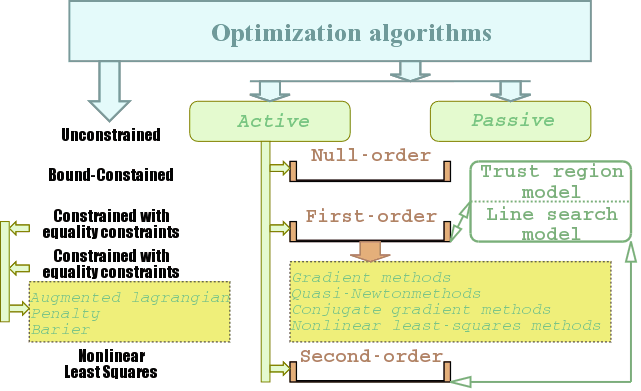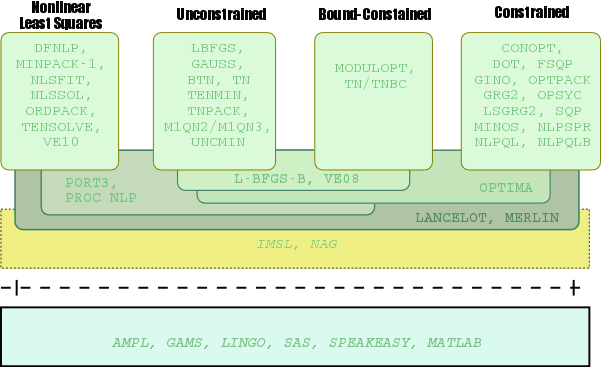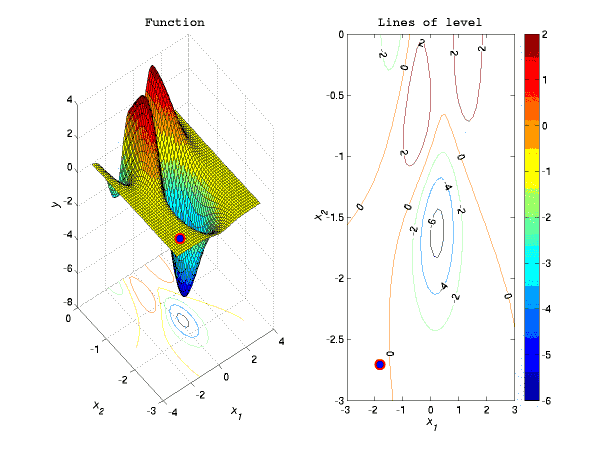
Theme of master's thesis:
"Research of locally deterministic methods of
mathematical programming"
Author: S. Gogolenko
Tutor: prof. dr.-ing. V.Svjatnyj
Consultants: M.Ginkel, K.Teplinsky

Theme of master's thesis:
Hunting for effective optimization algorithms was always one of the prioritiest trends of applied mathematics. High interest in the results of given applied mathematics' area is determined by presence of optimization processes in the nature as well as by aspiration of the people for the best organization of their activities. Thus optimization is an important tool in the analysis of phyzical systems and in decision-making.
The main aims of given work is research of the based on use of locally deterministic methods approaches to the solution of various optimization problems occurring in modelling of complex dynamic systems and building of effective locally deterministic optimization algorithms for solving of this problems. For achievement of given aims this work contains analysis of specificity, characteristic features and various ways of the most important in modelling of complex dynamic systems optimization problems' formulation, as well as known algorithms for the solving of optimization problems and software packages that realizes this algorithms. Practical result of this work is the development of an optimization's subsystem and its implementation in modelling environment Diana on the basis of which the further researches are carried out.
It is supposed, that in this work the new effective optimization algorithm (or group of algorithms) focused on the decision of the specific problems occurring in modelling of complex dynamic systems will be developed.
Detailed consideration of every possible optimization problems occurring in modelling of CDS allows to divide them into two groups.
The first group includes problems in which objective function and constraint functions are specified by formulas in explicit form. Similar problems usually arise as subtasks of other larger problems of modelling. They are characterized by the insignificant calculation's price of objective function, and also a little or an average count of unknowns. The gradient for such problems is calculated usually separately from criterion function with using of finite-difference approximations. Often the area of allowable values for problems of the first group is determined completely by functional constraints. The solution of such problems, basically, doesn't demand high computing power and can be found with using of classical optimization schemes.
The problems in which objective function is specified as superposition of some function and the decision of differential equations' (DE) system relate to the second group. If the model is described by system fo DE:
 (1.1)
(1.1) (1.2)
(1.2)It follows from the listed characteristics, that the problems concerning to the second group, demand significant revision of classical optimization algorithms, focusing the given algorithms on the small count of objective function's calculations and keeping of arising direct restrictions in mind.
The problem of model's parameter estimation concerns to the second group of problems. Formulation of the given problem can be made as follows [6, 8, 13, 14]. The model described by DE's system (1.1) and the set of the observation equations are given  . Some parameters p' and initial values of state variables x0' are unknown and form a vector of sought parameters
. Some parameters p' and initial values of state variables x0' are unknown and form a vector of sought parameters  . At the same time the matrix of measurements Y, describing experimental data is known. Elements of matrix Y are measurements of state variables at discrete times via the observation functions and are described by the equation:
. At the same time the matrix of measurements Y, describing experimental data is known. Elements of matrix Y are measurements of state variables at discrete times via the observation functions and are described by the equation:
 , (1.3)
, (1.3) denotes some normally distributed random noise. The aim is the estimation of sought parameters' vector depending on experimental data. Maximum likelihood estimator is used usually for solving of this problem. Then in the case of white Gaussian observation noise the problem takes on form:
denotes some normally distributed random noise. The aim is the estimation of sought parameters' vector depending on experimental data. Maximum likelihood estimator is used usually for solving of this problem. Then in the case of white Gaussian observation noise the problem takes on form:
 , (1.4)
, (1.4) denotes objective function,
denotes objective function,  and
and  denotes constraints based on physical reasons. Confidence intervals for estimated variables are determined by using of Fisher information matrixes [6, 12, 14] or other similar methods [8].
denotes constraints based on physical reasons. Confidence intervals for estimated variables are determined by using of Fisher information matrixes [6, 12, 14] or other similar methods [8].
In this case the important problem when using locally deterministic methods is the choice of an initial point. There are two approaches to this problem. First of them is called initial-value approach [8]. It supposes that after a suitable choice of initial guess the modelling equations are integrated over the entire fitting interval, and then function  is calculated by formula (1.4). The given approach demands using of method providing rough approach to a global minimum at the initial step. The most simple approach from this situation is using of some global stochastic optimizer. The genetic algorithm of optimization is chosen for further investigations in the given work.
is calculated by formula (1.4). The given approach demands using of method providing rough approach to a global minimum at the initial step. The most simple approach from this situation is using of some global stochastic optimizer. The genetic algorithm of optimization is chosen for further investigations in the given work.
It's possible also to use the alternative approach called multiple shooting method (MSM) [6, 8, 13, 14].MSM was introduced by van Domselaar and Hemker (1975) and proved theoretically by Bock (1981,1983). The given approach contains following steps. First fitting interval is divided by suitable grid into subintervals T0=t0<t1<...<tm=T0+T (fig.1). Each subintervals associate with the piece of an integrated trajectory with own unknown initial values of state variables x0(k). In addition all intervals have the same sought parameters of model p'. Each interval should contain at least one experimental point. As the resulting trajectory should be continuous, there appears some additional constraints, providing a continuity of a resulting trajectory at the moments of intervals' conversion. Finally the problem assume the following form:
 . (1.5)
. (1.5)
Despite of significant increase of unknowns' count in MSM, the given scheme possesses several advantages [13]:
There are some alternative approaches to classification of locally deterministic optimization algorithms (fig. 2.1).
The class of optimization problems which can be solved by algorithm serve as a criterion for algorithms' classification in the first approach [1, 2, 3, 5]. Since the most important special cases of mathematical programming problems are unconstrained optimization problem, bound constrained optimization problem, optimization problem with equality constraints, constrained optimization problem and nonlinear least squares problem there are allocated the following groups of algorithms according to this criterion:
The second approach is based on keeping in mind various criteria, which characterizes realization of algorithms [4, 11]. According to one of such criteria distinguish active (sequential) and passive methods of optimization. All points for the further analysis are chosen in passive methods simultaneously before calculations. Points are chosen sequentially in active methods, the choice of each point depends on values of previous points. Other criterion is the desired by algorithm information about objective function. If it's enough only the information about function's value in a point such algorithm concerns to null-order algorithms (Gauss method, simplex method of Nedler-Mid, Rosenbrock's methods, Powell's method, etc.). If gradient is required, the algorithm concerns to the first-order algorithms. Second-order algorithms require also the information about Hesse matrix except for objective function's value and its gradient (Newton method, classical SQP-methods). The most locally deterministic optimization methods belong to descent methods. This group of methods is based on two models. The first model is line search model, in which on each iteration descent direction is fixed and the step length is estimated. The second model is methods trust-region model in which on each iteration descent direction is estimated. First order descent methods includes following groups of methods [1, 9]:

At present there are developed a lot of optimization programs realizing locally deterministic algorithms. The most of these codes are distributed under GPL license, the part of codes requiring payment. All optimization software can be divided into three groups (fig. 2.2) [5]:

Yearly several tens of publications about optimization problems occurring in modelling of CDS appear. There are a lot of works, in which parameter estimation problem is discussed [19, 20], but multiple shooting method is poorly covered in the literature. Classical books of prof. H.Bock are practically inaccessible because of small circulation.
There are a lot of books and articles about locally deterministic optimization methods. Some of them attempts to cover all known locally deterministic optimization algorithms [1-4, 9-11], some works describes only separate chosen algorithm or group of methods [7, 15-18, 21].
In the given work initial value approach Is used for solving of problems occurring in modelling of CDS. In this case initial approach to a global minimum is found by genetic algorithm of optimization. Parameter estimation problem is solved in addition by MMS (see 1.2).
As for now LBFGS-B-method [7] is used as the main optimization algorithm. The direction in the given method is determined by formula (4.1):
 , (4.1)
, (4.1) ,
,  ,
,  .
.
In LBFGS-B-algorithm the similar to gradient projection method approach is used. Classical LBFGS-B-algorithm uses backtracking procedure for choosing of step length. In the given work it is planned to improve classical LBFGS-B-method by using of interpolation procedure for choosing of step length.

In the given work the main classes of optimization problems were briefly considered. Also this work contains brief review of optimization algorithms and optimization software. Currently in the context of work interfaces of main optimization problems and solvers are developed and implemented into modelling environment Diana. In addition gradient Armijo algorithm was realized, but research of this algorithm was stoped because the given algorithm didn't solve badly scaled problems. Instead of it in modelling environment Diana code of LBFGS-B-algorithm developed by P.Lu [7] was implemented.
Further it is planned to realize modified LBFGS-B-algorithm on C++ and to investigate efficiency of suggested modification on real parameter estimation problems with use of initial value approach and MSM, as well as to investigate one of nonlinear least squares algorithms.